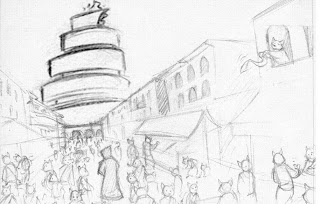First and foremost, Rachel has graduated from BYU and is balancing her Four Kingdoms work with a veritable mountain of other projects on her plate. Aside from that, I've also been keeping busy on a variety of new projects, from work-related game projects to a spectacular comic-writing opportunity with my good friend, Sean Rubin.
Have no fear, though! Progress continues on the comic, and our plan to have a solid pitch together for the next New York ComicCon is still perfectly on-track.
I figured that since it's been a few months since we really offered up a post, I'd treat you to something pretty in-depth and behind the scenes: a page's progress, from start to finish!

This is the first draft that Rachel did oh-so-long ago. This was obviously before any serious script edits, back when the comic script was basically ripped verbatim from the source material - which was, in fact, a novel. You don't need to be Scott McCloud to know that comics don't really support the exposition you can fit into a novel, so I had to really dive into other comics to see how they handled loads of exposition.
Long story short, they don't. At least, they don't in such a short period of time. I realized that I'd need to take a hacksaw to my script - not just here, but EVERYWHERE. I really took a good look at other comics in the genre, from Mice Templar to Mouse Guard, the latter really helping me figure out how to reduce word count using on-screen actions and expressions instead of nouns and verbs.
This panel also demonstrates some of the issues we had early on with paneling. The comic was originally laid out like a movie storyboard, with a lot of medium shots for expository sections like this. As Rachel eventually came to learn, comics have their own panel-to-panel language, and that would require a good deal of re-paneling.

This page on the left is a few revisions later. You'll see a few new things right off the bat. First, the script isn't as long. It's still long, but it's not quite as clunky and page-filling as it was in the original version.
Perhaps the biggest change here is in how the panels are laid out. Whereas the first draft consisted almost entirely of mid-range shots, this new version dares to go for the dramatic close-up, and also cuts away briefly to show the Juskadin in the third panel.
In general, this new layout represents the new direction we took after the initial draft, which was twofold: less text, and more diverse panel layouts. Close-ups, cutaways, dramatic angles - nothing is off-limits! If it makes the scene more interesting, we're all about trying it.

Finally, we have the completed page on the right. I did leave out a few steps before, like the completed inks and lighting studies that Rachel did, but we must maintain SOME level of mystery, yes?
It still amazes me just how much nicer things look in color! Sure, there are some excellent black & white comics out there (Bone popping into my head almost instantly), but I just love the palette that Rachel went with here - it really represents the heart of Four Kingdoms, which is a combination of dark fantasy themes and homages to classical animated films.
The Lutren army uniform, with the wave motif, just pops right out of the page when it's in color. Also, the third panel, with its silhouetted malice, really turned out well.
The re-panels and page colorings continue, along with a variety of other pitch materials, such as character portraits, maps, covers, all that good stuff. As things move along, rest assured we'll stick it here for you to see!















